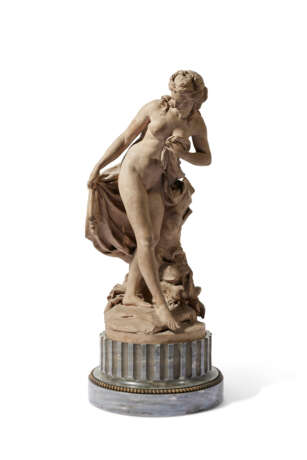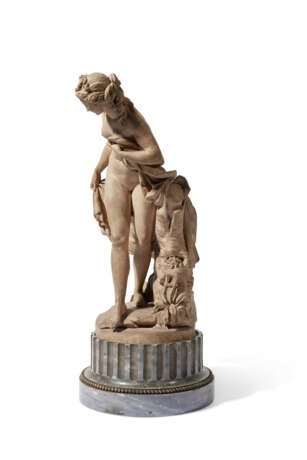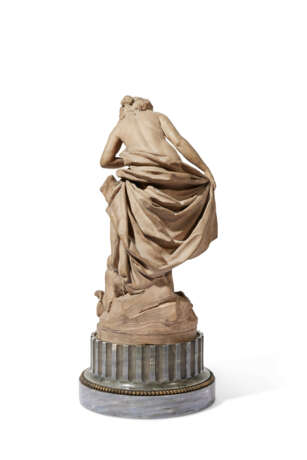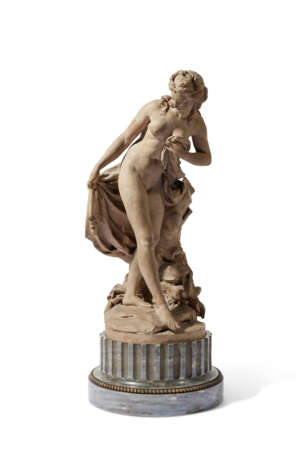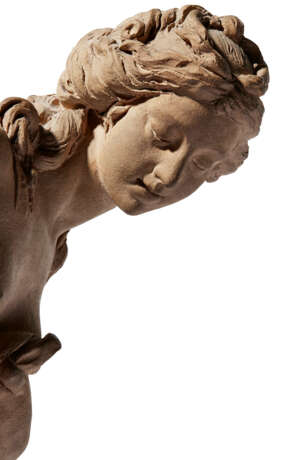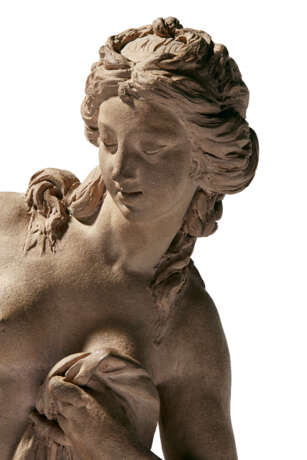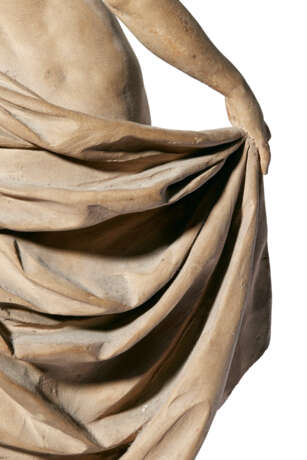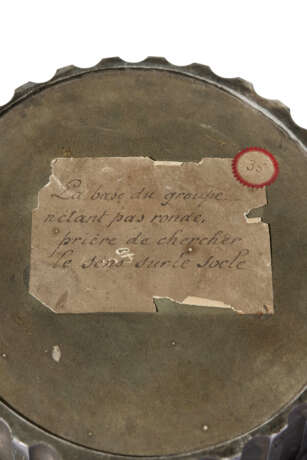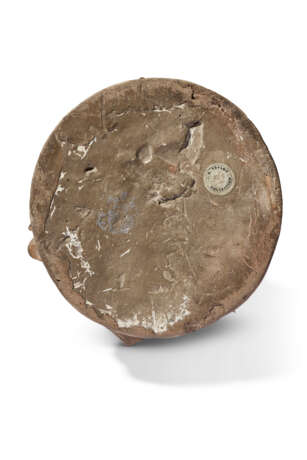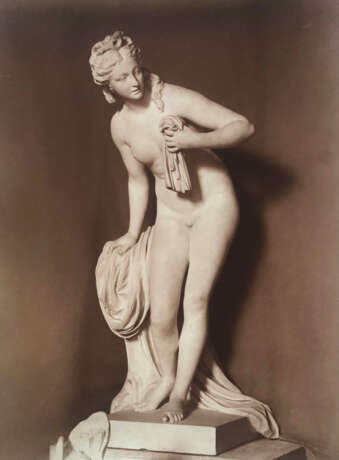ID 1172990
Lot 61 | VÉNUS AU BAIN OU BAIGNEUSE
Estimate value
€ 15 000 – 25 000
D'APRÈS CHRISTOPHE-GABRIEL ALLEGRAIN (1710-1795) ET ÉTIENNE MAURICE FALCONET (1716-1791), SECONDE MOITIÉ DU XVIIIe SIÈCLE
terre cuite, le dessous avec l'étiquette circulaire inscrite ‘COLLECTION J. E. TAYLOR / 568’, sur une base en marbre bleu turquin et perles de bronze doré portant les étiquettes ‘La base du groupe / n’étant pas ronde, / prière de chercher / le sens sur le socle’ et ‘35’
H. 44,5 cm (17 ½ in.)
La base : H. 11,2 cm (4 ½ in.) ; D. 24,5 cm (9 ½ in.)
Provenance
Collection John Edward Taylor, 20 Kensington Palace Garden, Londres ; sa vente, Christie's, Londres, 1-9 juillet 1912, lot 568, où achetée par le marchand Durlacher.
Collection privée, Suisse.
Literature
‘The Taylor Collection’, in The Connoisseur. A Magazine for Collectors, septembre 1912, vol. XXXIV, no. 133, p. 30.
L. Réau, Étienne-Maurice Falconet 1716-1791, thèse pour le doctorat présenté à la Faculté des Lettres de l’Université de Paris, tome 1, Demotte, Paris, 1922, p. 197.
Bibliographie comparative :
C. Béziès, ‘Christophe-Gabriel Allegrain (1710-1795)’, in Bulletin de la Société de l’Histoire de l’Art Français, 2000, pp. 157-180.
Further details
A TERRACOTTA FIGURE OF VENUS OR A WOMAN BATHING, AFTER CHRISTOPHE-GABRIEL ALLEGRAIN (1710-1795) AND ÉTIENNE MAURICE FALCONET (1716-1791), SECOND HALF 18TH CENTURY
The subject of Venus or a nymph taking the bath, a pretext for revealing the female body, has been eagerly treated by sculptors of all periods since Antiquity. Eighteenth-century artist revived this predilection, such as Étienne-Maurice Falconet (1716-1791) and Christophe-Gabriel Allegrain (1710-1795). Although the latter produced figures of bathers in the same years, they differed in their attitude and movement. Whereas Allegrain chose the woman drying herself after bathing, Falconet preferred to depict his nymph before bathing. Allegrain’s Venus is portrayed in a contoured attitude with a very pronounced hip, which contrasts with Falconet’s bather, who is depicted with straighter, simpler contours. What is more, Allegrain depicts a fully mature bather, with a body that gives the ‘feeling of flesh made of marble’ (Levesque), whereas Falconet describes a graceful, childlike Venus with a very smooth skin. Eighteenth-century auction catalogues bear witness to the success enjoyed by Falconet’s bather, proving the existence of numerous versions of this figure by or after the sculptor, in a variety of materials including marble, wood, terracotta and biscuit porcelain.
The sculpture presented here was part of the collection of John Edward Taylor (1830-1905), son of the founder and later owner of the British newspaper The Manchester Guardian (from 1959 The Guardian). Our Venus was previously attributed to Falconet (Christie’s, London, 1 July 1912, lot 568). New observations now lead to reconsider this attribution. The treatment of the flesh, the attitude, the gestures and movements are more reminiscent of Allegrain’s Diana surprised by Actaeon (Musée du Louvre, inv. MR 1746), and indicate a style closer to the latter sculptor’s work. The Louvre’s Diana, commissioned in 1772 by the Comtesse du Barry, was intended to be a counterpart to the same artist’s Venus, created in 1767 and presented to the countess by Louis XV in 1772. Placed in Louveciennes, Diana was then sent to Versailles, and later to the Palais du Luxembourg, before joining the Louvre in 1824.
Christophe-Gabriel Allegrain was born in Paris in 1710. He was the grandson of the landscape painter Étienne Allegrain (circa 1650-1733), and the son of Gabriel Allegrain (circa 1680-1733), also a landscape painter and member of the Académie. Christophe-Gabriel probably received lessons from his father. In 1733, he married Geneviève-Charlotte Pigalle, daughter of the carpenter Jean Pigalle and sister of the sculptor Jean-Baptiste Pigalle (1714-1785). He was admitted to the Académie royale de peinture et de sculpture in 1748, becoming a member in 1751, a professor in 1759 and rector in 1783. We know of very few sculptures by Allegrain, who must certainly have worked in his brother-in-law’s studio on numerous works signed by the latter.
| Applied technique: | Pottery |
|---|---|
| Medium: | Marble, Ceramic, Stone, Terracotta |
| Genre: | Mythological painting |
| Place of origin: | Western Europe, France, Europe |
| Auction house category: | All other types of objects, Sculptures, Sculptures, Statues & Figures, Statuettes |
| Applied technique: | Pottery |
|---|---|
| Medium: | Marble, Ceramic, Stone, Terracotta |
| Genre: | Mythological painting |
| Place of origin: | Western Europe, France, Europe |
| Auction house category: | All other types of objects, Sculptures, Sculptures, Statues & Figures, Statuettes |
| Address of auction |
CHRISTIE'S 9 Avenue Matignon 75008 Paris France | ||||||||||||||
|---|---|---|---|---|---|---|---|---|---|---|---|---|---|---|---|
| Preview |
| ||||||||||||||
| Phone | +33 (0)1 40 76 85 85 | ||||||||||||||
| Fax | +33 (0)1 40 76 85 86 | ||||||||||||||
| Conditions of purchase | Conditions of purchase | ||||||||||||||
| Shipping |
Postal service Courier service pickup by yourself | ||||||||||||||
| Payment methods |
Wire Transfer | ||||||||||||||
| Business hours | Business hours
|
